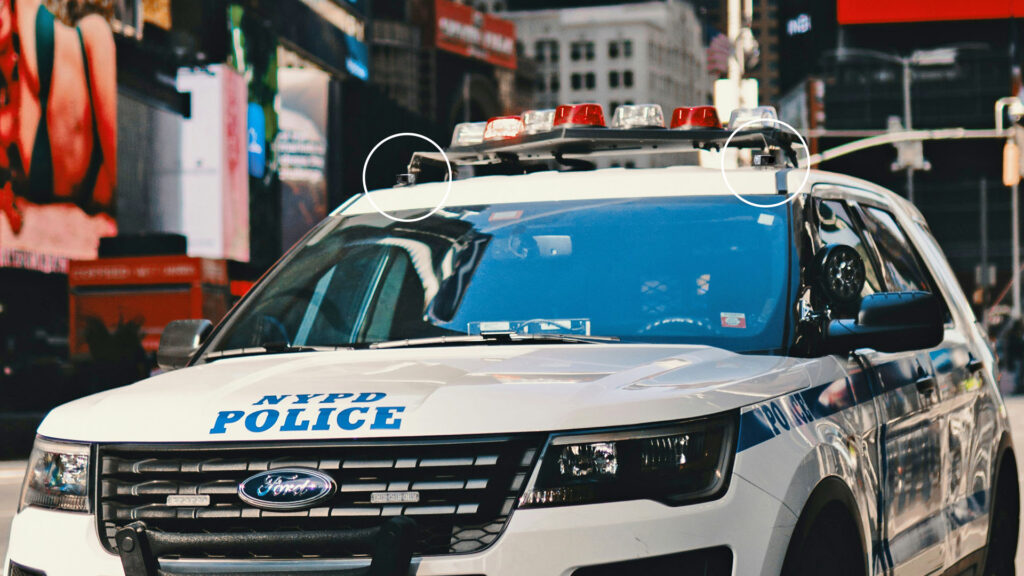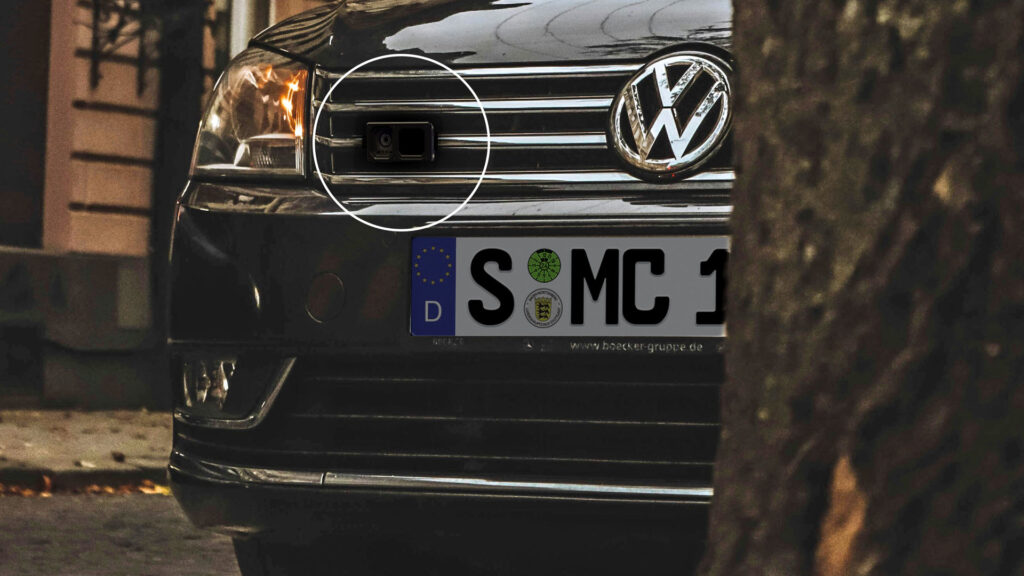Traffic enforcement cameras have been around for decades, but their role has really taken off in recent years. Advancements in automatic recognition of license plates, vehicle make, model, category, and color, combined with mobility and real-time data processing, have made these technologies essential tools for tracking traffic, identifying stolen vehicles, and enhancing public safety. What was once static surveillance is now a dynamic, mobile solution that allows police to respond to emergencies faster and more accurately.
But what makes vehicle-mounted mobile ALPR cameras such a game-changer? The answer lies in their unmatched flexibility and cost-effectiveness—offering revolutionary benefits for law enforcement. These cameras are incredibly easy to set up in various locations and are practically invisible due to their ultra-small size, giving officers the flexibility to monitor areas prone to traffic violations or crime. And that’s not all—because they can be deployed unpredictably, they create a powerful deterrent. Drivers never know where enforcement will pop up next!
Mobile police car cameras offer broader coverage without the need for permanent infrastructure, making them perfect for fast-moving enforcement situations. Plus, they allow for quick responses—essential when time is of the essence.

Mobile ALPR Cameras Deliver a Vital Boost for Covert Operations
Covert operations are a game-changer in modern crime fighting, allowing law enforcement to gather intel and monitor criminal activity without tipping off suspects. These undercover tactics are key for tracking wanted vehicles, infiltrating criminal networks, and keeping an eye on suspicious movements. By working quietly behind the scenes, officers can capture hidden evidence while keeping risks low for both themselves and the public.
And this is where mobile law enforcement LPR cameras come into play. With tools like covert cameras and mobile LPR systems, authorities can now gather critical data discreetly and efficiently, even in the trickiest of situations. These patrol car cameras are transforming the way undercover operations are carried out, making it easier to stay one step ahead of crime.
LPR cameras for law enforcement (e.g., Adaptive Recognition’s Lynet camera) capture critical data such as license plates, vehicle make, model, and color, as well as time stamps and GPS coordinates, creating court-admissible evidence. This enables officers to monitor wanted vehicles, gather intelligence, and track suspicious movements in real time, all while maintaining a low profile. With the ability to quickly move to high-priority areas, mobile police LPR cameras are transforming undercover operations, ensuring law enforcement stays one step ahead.
7 Ways Mobile ALPR Cameras are Revolutionizing Law Enforcement: Real-World Applications in Action
Ever wondered how mobile LPR cameras are changing the game in law enforcement? From tracking suspects to enhancing traffic enforcement, these cameras are making a significant impact on the ground. Let’s explore some real-world applications where these cameras are making a difference, driving positive change in automated traffic enforcement operations.
- Speed Enforcement: Catching Speeders in the Act
Speeding on highways or in busy traffic zones? Not under the watch of these mobile speed enforcement cameras. These discreet devices mounted on police cars catch those who violate traffic laws, and the best part is, unlike fixed ANPR cameras, they can be anywhere. This means those who try to ignore the rules because they think there are no fixed cameras nearby are still caught. It’s a different kind of deterrence compared to fixed cameras. When combined with certified radar technology, cameras like the Lynet Speed don’t just capture license plates—they accurately measure speed in real-time, with a time stamp and GPS coordinates, making the evidence court-admissible. This makes them a game-changer in areas where traditional speed enforcement methods fall short. With instant monitoring, these police speed cameras help cut down on speeding, reduce accidents, and keep our roads safer for everyone.

- Monitoring Restricted Zones: Keeping Unauthorized Vehicles in Check
Certain areas in cities—like congestion zones, heritage sites, or private property—require special permits for entry or restrict access to newer, low-emission vehicles to minimize pollution. This policy encourages car owners to make environmentally friendly upgrades to their fleets. Mounted police dash cameras keep a watchful eye on these restricted zones, instantly detecting unauthorized vehicles and sending real-time alerts. Whether it’s for issuing penalties or gathering evidence for further action, these cameras provide the flexibility to deploy wherever and whenever needed, making law enforcement operations more efficient and effective.
- Toll Collection and Compliance: Making Tolls Seamless and Fair
Toll roads just got smarter with automated toll collection systems powered by LPR cameras. These mounted devices are perfect for highways where fixed cameras or toll gates have not yet been deployed, effortlessly monitoring vehicles passing through toll stations and ensuring every driver pays their fare. Ideal for highways where manual toll collection is impractical, these cameras also catch those attempting to dodge their tolls, promoting fairness and efficiency.
Additionally, this discreet surveillance is invaluable for tax authorities in monitoring trucks that might try to avoid toll roads to evade payments. These cameras record passing vehicles, capturing details such as license plates, make, model, color, timestamps, and GPS coordinates—creating admissible evidence for fines. With law enforcement surveillance cameras in action, tolling becomes smoother, more reliable, and fairer for everyone on the road.
- Wanted Vehicle Detection: Catching Lawbreakers on the Move
Tracking wanted vehicles just got a whole lot easier. With advanced police car license plate reader cameras, law enforcement can scan vehicles on the road in real-time, cross-referencing license plates against criminal databases to flag stolen or suspicious cars. Whether it’s during a high-speed chase or on a congested street, these cameras provide a fast, automated way to locate criminal vehicles and enhance community safety.
But it doesn’t stop there. These systems can also cross-reference license plates with insurance databases or other vehicle-related records, flagging cars with expired registrations, lapsed insurance, or other compliance issues. This means vehicles with paperwork problems can be quickly identified, and fines issued accordingly. No more relying on chance—just efficient, precise monitoring for traffic safety at every turn.
- School Bus Safety: Protecting Our Kids, One Stop at a Time
When school buses are on the road, safety is the top priority. In the U.S., traffic laws prohibit vehicles from passing a school bus while it is stopped with its red stop sign extended—but not all drivers follow the rules. That’s where school bus cameras come into play. These police surveillance cameras automatically detect and record vehicles illegally passing a stopped school bus, capturing crucial evidence to hold violators accountable.
By ensuring that drivers obey stop laws, these cameras play a vital role in keeping kids safe during pick-up and drop-off. It’s a simple yet powerful way to protect our children and prevent accidents. Additionally, this type of mounted surveillance can also monitor buses or restricted bus lanes, further enhancing road safety for everyone.
- Covert Operations: Tracking Crime Without Being Seen
In undercover operations, stealth is everything. Discreetly mounted police number plate scanner cameras are the ultimate tool for staying unnoticed, seamlessly blending into patrol cars and strategic environments. These advanced devices enable law enforcement to monitor suspects and track criminal activity in real-time – all without tipping off the target. Whether it’s a covert investigation or discreetly observing suspicious behavior, these cameras are invaluable for maintaining secrecy and ensuring operational success.

Additionally, these cameras excel in locations lacking the infrastructure for fixed systems, such as areas without reliable internet connectivity or power sources. Devices like Adaptive Recognition’s Lynet camera not only capture and store critical evidence but can also synchronize data in real-time with command centers and field agents. This combination of adaptability and reliability makes them indispensable for law enforcement, even in the most challenging environments.
If any of these scenarios resonate with you, connect with our experts to find the perfect camera component for your system. With the right resolution and computing power, our cameras can seamlessly integrate into your applications to support your specific tasks.
Pro Tip: What to Look for in an Enforcement Camera System
Choosing the perfect enforcement camera is about more than just the hardware—it’s about how well it aligns with your team’s needs. Here are the key points to consider:
- Accuracy is Non-Negotiable: Go for advanced ANPR/ALPR technology to ensure reliable recognition, even in tough conditions like bad weather or poor lighting.
- Integration Matters: Your camera should sync seamlessly with criminal databases, traffic systems, or tolling solutions for smooth, real-time operations.
- Mobility vs. Fixed Placement: Need flexibility? Mobile cameras are great for patrol vehicles. For permanent setups, explore our Vidar ANPR cameras, or connect with us to discuss the best fixed solution for your needs.
- Radar-Certified for Speed Enforcement: Ensure precision when monitoring speed violations on busy roads or highways.
- Data Security First: Look for encryption and compliance with data protection laws to safeguard sensitive information.
- Size Matters: Choose discreet and lightweight cameras that can be installed in the grille or under the police car’s light bar for seamless integration.
- Ease of Use: A user-friendly interface is crucial for efficient operation, even for less tech-savvy officers.
The right enforcement camera doesn’t just streamline operations; it enhances safety, simplifies processes, and delivers results that count.
Conclusion
Mobile ALPR cameras for law enforcement are invaluable in modern crime prevention and traffic management. Their flexibility, efficiency, and ability to gather critical, court-admissible evidence in real time make them a vital tool for tackling a wide range of enforcement challenges.
Whether for covert operations, monitoring high-violation zones, or adapting to unpredictable traffic patterns, these cameras enhance law enforcement’s capacity to act swiftly and accurately. With their seamless integration into various enforcement strategies, mobile ALPR cameras are not just changing the way officers operate – they are helping create safer, more secure communities for everyone.


